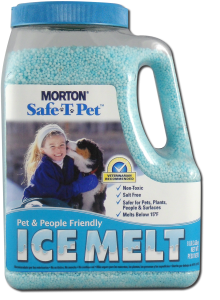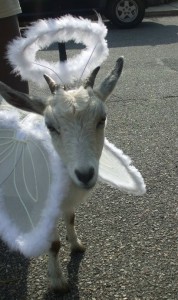Archive for the ‘safety’ Category
When we think of Morton’s salt we usually think of seasoning our food with it. But this year they have a new product just for pets Morton’s Safe-T-Pet™ which is a safe non-toxic ice melt to de-ice the winter wonderland outside your door. Morton Salt, the brand consumers have trusted and welcomed into their homes for more than 100 years, has developed a full line of specialty ice melt blends and salt-free ice melt products to help make your winter season more manageable and less stressful for you and your pets. See below for some excellent tips for keeping your pets safe through the winter and be on the lookout for our upcoming photo contest where you can win an 8lb container, (and lots of other prizes), of Morton’s pet and people friendly ice melt.
Keeping Pets Safe This Winter
Walking in a winter wonderland can be hazardous for our four-legged friends. “The winter months can be a very dangerous and uncomfortable period for pets,” says Dr. Sharon Gwaltney-Brant, a veterinarian and board-certified toxicologist. With the help of Dr. Gwaltney-Brant, Morton Salt, Inc. provides a few tips for keeping your pets safe this snowy season:
- Remember Their Tags – Dogs may love to frolic in the snow, but they can easily lose their scent and become lost in all that white. More dogs go missing in the winter than any other season, so keep them on a leash and ensure they are always wearing an ID tag.
- Protect Those Paws – The salted sidewalks and streets are very hard on pets’ paws – but there is a solution. Morton® Safe-T-Pet™, developed with veterinarians, is a salt free and chloride free ice melter which melts below 15 degrees Fahrenheit. Its urea-based, organic formula is non-toxic and non-irritating to pet’s paws and stomachs. Some other ice melters on the market mislead consumers regarding how well the product melts and how safe the product is. For example, when testing was conducted by Michigan Technological University Keweenah Snow Research Center, the Safe Paw™ ice melt product did not melt snow and ice at sub-zero temperatures as claimed. Other brands claim to be pet-safe but actually contain chlorides which can be harmful to pets digestive systems if ingested and which can be painful or irritating to pets’ paws. So make sure you look for a chloride free melter from a company you can trust to validate claims and put safety first.
- Avoid Toxic Temptations – The sweet taste of antifreeze solution is attractive to pets, but is highly toxic even in the smallest amounts. Be sure to keep all chemicals sealed on a high shelf, away from your furry friends, and clean up spills as soon as they happen.
- Winter Weight, Be Gone – Just like humans, animals are less active in the winter and don’t burn as many calories. Keep your pets healthy by reducing their diet to avoid winter weight gain. Speak with your veterinarian about proper diets during “hibernation” season.
- Warm Home, Cold Floors – It is important to remember that although your home may be warm, there may still be drafty areas. Make sure your pets have something soft to sleep on (away from drafts) to protect them from the cold floor.
- Holiday Treats for Humans Only – When throwing those much anticipated holiday parties, be sure to keep all chocolate, macadamia nuts, alcohol and even mistletoe and holly berries out of reach. Although seemingly harmless –these can be dangerous if ingested by pets.
- Running Out, Be Back Soon – Do not leave your dog in a car during the winter months. This enclosed space freezes fast, so if you are running errands be sure to leave your pet at home in the warmth of your home or keep them by your side when out and about.
- Wipe Down To Stop Whining – In addition to selecting a pet-friendly ice melter, be sure to towel off your pet after time outside to remove salt and other irritants from their paws and skin. At the same time, inspect the paw pads for any collection of snow or ice to ward off winter weather problems.
by Nancy E. Hassel, LIPetPlace.com
Dog training for Winter safety
Here on Long Island we are so lucky to be surrounded by water, have many lakes, ponds streams and natural areas to enjoy with our pets. Recently after reading a story in Newsday about a Shirley man who’s 2 off leash Husky’s ran after some geese over the thin ice of a pond and fell through. In an effort to save his dogs the owner also fell through into the cold water. The owner admitted it wasn’t too smart, not thinking the ice was too thin or the cold water too deep and found himself in, well, deep water. Thankfully this story has a happy ending where a neighbor happened to hear the man yelling for help and the man and his dogs were all rescued and are all okay. But it made me think, how many people teach their dogs not to go on the ice? It’s not something you think about every day, especially if you get adopt a puppy or dog in the spring, summer or fall. It made me think back to how I taught my first dog, and dog I currently own to be safe near ice.
When I got my first dog as an adult, a young female puppy Doberman in the late summer of 1995, I did a lot of training with her in many different places. One place more than others, happened to be a park with wooded trails, streams and a lake. That first winter, the then 8-month old puppy was very curious about the strange frozen occurrence that the lake had become. While wanting to show her the ice, I also didn’t want her to think it was safe to walk out onto. So without taking a dog training course on winter safety and going on my instincts, I let her sniff the ice, put a front paw or two on it, but never ever let her walk out onto the ice. Using various commands, “off” if she ventured more than one paw onto the ice, or “stay” to keep her by me, or using “eh ah” if she tried to step on it. Of course this was all done while she was on a leash and giving her verbal praise as a reward. I also let her step on a frozen part right near the edge that I knew would break apart, you know those couple inches of water at the edge that freeze but can still be cracked pretty easily – showing her that it would break. Doing this repeatedly throughout the winter months, trained her not to ever step out onto the ice. Each winter after that I would do a refresher near the first frozen body of water we came upon. I was lucky to have one ridiculously smart dog, who learned quickly and seemed to understand the danger. She was also trained to heel, so when in the presence of ducks, geese or any other wildlife she would not chase an animal. Of course a dog being a dog, she still had instincts to want to chase but having her trained on a verbal recall, helped in having to worry if she did get off leash near ice. I did all these same winter training rituals with my current dog, and he too learned quickly, and it didn’t hurt that he was scared of the ice to begin with. (He also learned by watching her not go on the ice.)
You also have to keep in mind what breed of dog you have too. If your dog was specifically bred for hunting, chasing out birds or is a water dog, you still want to teach your dog winter safety training. Just because your have a Chesapeake Bay Retriever doesn’t mean it can get out of a dangerous situation like falling through ice in a middle of a lake.
Winter can be a lot of fun for us and our dogs, but teaching a dog to stay, come on command and never letting your dog off leash near thin or thick ice, are vital to keeping our dogs safe – and ourselves for that matter. Now that the weather is getting cold enough for ice to begin to form across many of our lakes, ponds, and bays – think about training your dog with winter safety in mind. If you are not sure how to do this properly, consult a dog trainer and ask them for a winter safety training session or two.
Another thing a pet owner should know, whether your pet is a dog or a cat is pet first aid and CPR – especially if your pet falls through ice. We are fortunate to have a local certified Pet Tech, Robyn Elman that teaches a class in pet first aid and CPR, including what to do if your pet gets frostbite and hypothermia. The vital information taught in the class has already saved the lives of a few pets of past class participants. These pet owners who knew what to do in an emergency situation, all thanks to the information they learned in Robyn’s class. To find out more information on the upcoming January 22, 2011 class click here. Interested parties should sign up soon, as this course fills up fast and is offered about every six weeks.
by Nancy E. Hassel, LIPetPlace.com
This is the time of year when we as humans indulge on all kinds of goodies, from Thanksgiving turkey, trimmings, pumpkin pies and a lot of food we would not normally eat on a daily basis. A lot of dog owners think they should give our dogs whatever we are eating as their holiday treat. You may feel guilty with those puppy eyes looking back up at you while they are licking their chops, but wait, stop and remember that guilt is a human emotion. Indulging your pet with all the yummy goodness of a Thanksgiving meal, could just have you spending that night in the ER for pets.
Some dogs, if they are not used to eating turkey, pumpkin or sweet potato pie, can get sick from it. So make sure you refrain from giving your dog foods they are not used to and also ask your guests to do the same. Dogs are better off eating what they are normally fed during the holiday season. With the rushing around in this busy time of year, you may not notice your dog not feeling well because someone gave him the turkey thigh. If you really want to give your dog a special treat, go to your local pet store and buy a dog treat – make sure it is veterinarian approved and made in the USA and don’t leave your dog unsupervised with it. This time of year, veterinarian offices see a pretty big spike in visits from gastrointestinal problems i.e.: dogs not used to eating table scraps, blockage from ingesting a toy or toy part (while no one was watching) and it could require surgery.
Before your friends and family are coming over for Thanksgiving, take your dog for a nice long walk, you know the saying goes, a tired dog is a good dog. There are many beautiful places here on Long Island to do so, and it will be good for you to. Keep your dog healthy on Thanksgiving and throughout the holiday season. Happy Thanksgiving!
by Nancy E. Hassel, LIPetPlace.com
Did you know that cats that are exposed to 2nd hand smoke have a higher incidence of getting lymphoma, skin cancer and mouth cancer? According to a Tufts School of Veterinary Medicine study which found a strong connection between environmental tobacco smoke (ETS) and oral and skin cancer in cats. Cats living with smokers had higher incidence of these types of cancer and cats living with more than one smoker and exposed to ETS for a period longer than five years have an even higher incidence of these cancers.
Mouth cancer may seem strange for a cat to get due to 2nd hand smoke, but because cats groom themselves daily, a cat living in a smoking housed hold can lick up carcinogens that have landed on their fur. If a cat is exposed to 2nd hand smoke over a long period of time they can be exposed to carcinogens in dangerous amounts.
With dogs, 2nd hand smoke is associated more with nasal sinus cancer, especially in breeds that have longer noses such as Dobermans, Greyhounds or Collies. According to a study done by Colorado State University found that the risk of nasal cancer was significantly higher for long-nosed dogs exposed to household ETS than for unexposed animals, although there was no evidence of an increase in risk for short-nosed breeds.
While primary lung cancer is not common in cats and dogs, according to Dr.
Keith Niesenbaum of www.CrawfordDogandCatHospital.com in Garden City Park said, “I have definitely seen pets with chronic airway disease that I believe is caused or exacerbated by poor environmental air quality. This includes stuffy, moldy, stale air and second hand smoke. We have seen clinical improvements in patients as a result of cleaning up the environment [in which the pet lives in].”
While it can be extremely difficult for humans to quit smoking, but pets don’t have a choice if they are living in a smoking household. Thursday, November 18, 2010 is the 35th Annual National Smoke Out encouraging smoker’s trying to quit, to not smoke the entire day. Hopefully pet owners that happen to smoke and want to quit will make a healthier choice for themselves and their pets on the 18th.
by Pamela Fitzpatrick, of YourDogWalkers, shihtzu58@optonline.net
Halloween Safety Tips for your Pets!
Halloween is only a few days away and with pet costume parades, parties and trick-or-treating happening across Long Island many people want to include their pets in the fun. People often take their dogs along when trick or treating with their children, and those doggie costumes sure are cute! Here are some things that can help keep your pets safe when October 31 rolls around.
Costumes
Halloween can be a wonderful time spent with our pets, many people will adorn their dog, cat, goat or horse in costumes – but keep in mind not all pets like to wear clothes. If you decide to dress up your pet please make sure it’s not too stressful for them. Some animals are fine with costumes, but it can be a great source of anxiety for others. Just like their human counterparts, pet costumes should be properly sized, and non-constricting. Check for vision obstructions, and buttons, strings or ties that could create a choking or strangulation hazard. Remove the costume if your pet is unattended. A tip to help your pet get accustomed to wearing a costume is have them wear it in the house for a little while each day while supervised, to get used to it. If your pet absolutely refuses, fights you, tries to “rub off” the clothing – then a costume is not for your pet. Never force your pet to wear a costume!
Trick-or-Treating
Since Halloween is on a Sunday this year, there are more likely to be more trick-or-treaters ringing your door bell and a lot more activity in your neighborhoods. Some pets do great and don’t seem to mind, but others can be very nervous or frightened with the constant knocking, door bells going off, strangers in costume, etc. It’s probably best to keep your dog and cat away from your front door when the neighborhood children come to call. Dogs and cats are often frightened by all the commotion. A more adventurous pet might see the open door as an opportunity to bolt. Just in case, make sure your pet has proper identification on at all times. There’s always the possibility that a dog could view costumed visitors as a threat, (even someone they know) so don’t take any chances. Never leave your pet outside on Halloween. They could easily be harmed or stolen. Black cats are particularly at risk this time of year. Also if you don’t normally you’re your pet, don’t make Halloween a day to do so, costumes and screaming kids could definitely make it an unpleasant experience. Finally, make sure you pet doesn’t eat any of the trick-or-treat candies – many ingredients are toxic to dogs and cats.
Holiday Decorations
Candles create a spooky ambiance, but they are easily knocked over by pets (and kids!). Consider using battery operated candles, which flicker realistically and are worry free. Always keep spider webbing, balloons, and other decorations out of your pets reach.
With a little planning, you can have a safe and fun day that includes the four-legged members of your family. Happy Halloween!








Categories
Archives
Blogroll
Meta